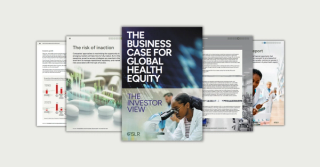
The next evolution in sustainability reporting: Why people are the new measure of resilience
by Jessica Barua
View post

Sustainability reporting is rapidly evolving to focus not only on environmental impacts but also on people, including workforce protection, equity, and community well-being. This shift reflects growing recognition that strong human systems are essential for financial stability and long-term resilience. Organizations investing in health, safety, and fair working conditions tend to be more productive, innovative, and adaptable.
The Taskforce on Inequality and Social-related Financial Disclosures (TISFD), established in 2024, marks the next major development in sustainability reporting. Inspired by initiatives like the Taskforce on Climate-related Financial Disclosures (TCFD) and the Taskforce on Nature-related Financial Disclosures (TNFD), the TISFD is creating a global framework to help organizations understand, disclose, and reduce social impacts on workers, communities, and society. Its first beta disclosure framework is expected in 2026, followed by consultation and refinement. The TISFD aims to clarify how organizational treatment of people links to financial and systemic risks, acknowledging that inequality, unsafe workplaces, and poor well-being are material business risks, not just social matters.
The TISFD emphasizes that human well-being, nature, and climate are deeply connected. Climate change and environmental degradation directly affect how, when, and where people can work. Rising temperatures, extreme weather, wildfire smoke, and poor air quality are introducing new occupational hazards across industries. Water scarcity, land degradation, and biodiversity loss threaten livelihoods and the continuity of supply chains.
When health and safety are compromised, productivity drops, communities lose resilience and economies become more fragile. Therefore, sustainability plans should be designed with a “people-first” lens. For example, climate transition plans that focus on decarbonization also need to consider how changing environmental conditions affect worker exposure, operational safety, and access to safe work environments. Healthy ecosystems sustain healthy people and healthy people sustain resilient economies.
Occupational health and safety (OHS), including the specialized field of industrial hygiene (IH), focuses on preventing harm by evaluating and controlling workplace hazards. Under TISFD, the OHS and IH practices move from basic compliance reporting—such as injury, illness and incident notifications—to being recognized as financially material business priorities. While existing frameworks such as GRI and ESRS cover OHS performance, they focus mainly on direct operations and compliance. TISFD will require disclosures on outcomes achieved, management of risks across value chains, and evaluation of how work conditions affect broader inequalities. Over time, this approach is expected to align and strengthen major reporting standards, potentially embedding workforce health and safety metrics as mandatory regulatory requirements.
OHS and IH practitioners serve a key role in linking workforce well-being with business performance. Data on exposures, psychosocial health, and preventive programs can demonstrate that sustainability commitments result in tangible improvements—not just aspirations.
Practical examples include:
SLR helps organizations strengthen the link between health, safety, and sustainability with strategic OHS advisory services. We support clients in embedding OHS and IH principles across decision-making, governance, and long-term strategy.
We work with clients to evaluate systems, identify gaps, and develop integrated management frameworks that align safety, sustainability, and business outcomes. Our advisory follows the full Plan–Do–Check–Act cycle:
Plan – Assess and Design
Do – Implement and Control
Check – Monitor and Evaluate
Act – Improve and Integrate
The TISFD signals a pivotal shift in how organizations report and manage human capital. By connecting workforce well-being to financial and systemic outcomes, OHS and IH gain strategic influence beyond technical guardianship. At SLR, we help clients connect safety, sustainability, and strategy, recognizing that protecting people is the foundation of resilient, sustainable growth.
This Insight is part of our In Focus series. Learn more about the author below.
Occupational Health & Safety - Jessica Barua
by Jessica Barua

by Hattie Godber, Alexia Koch, Belinda Ridley

by Alexia Koch, Rupali Patni, Stéphanie Finet